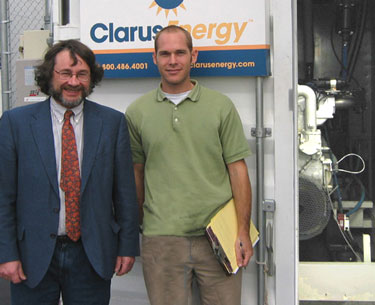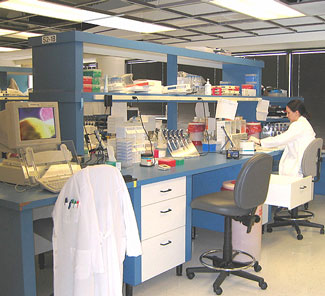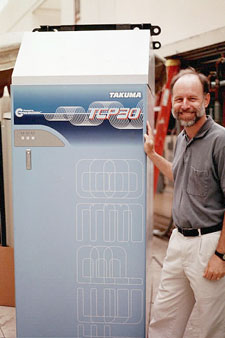|
|
 |
In 1996, a sagging power line in Oregon brushed against a tree, and within
minutes 12 million customers in eight states lost power. Such is the vulnerability
of today's power grid.
To address this weakness, Berkeley Lab scientists are helping to develop
a new approach to power generation in which a cluster of small, on-site
generators serves office buildings, industrial parks, and homes. Called
a microgrid, the system could help shoulder the nation's growing thirst
for electricity — estimated to jump by almost 400 gigawatts by 2025
— without overburdening aging transmission lines or building the
1,000 new power plants required to meet this demand. And it may make statewide
blackouts a thing of the past, or at least ensure that service to critical
equipment is maintained.
"Catastrophic loss of power to all systems like the 1996 blackout
should be impossible," says Chris Marnay, an energy scientist in
Berkeley Lab's Environmental Energy Technologies Division. "If we
sat down today to devise a power system from scratch, our design wouldn't
resemble the one we have."
|
 |
|
| Chris Marnay (left) and Ryan Firestone
of Berkeley Lab's Environmental Energy Technologies Division stand
in front of generators that power and heat a laboratory at BD Biosciences
in San Diego, Calif. The Consortium for Electric Reliability Technology
Solutions (CERTS) is studying this project as an early example of
on-site power generation. |
|
Instead of relying solely on large power plants, a portion of the nation's
electricity needs could be met by small generators such as ordinary reciprocating
engines, microturbines, fuel cells, and photovoltaic systems. A small
network of these generators, each of which typically produce no more than
500 kilowatts, would provide reliable power to anything from a postal
sorting facility to a neighborhood.
This microgrid appears to the larger grid as if it's any other customer.
And it can quickly switch between operating on and off the grid: when
the grid offers cheap electricity, the microgrid can purchase it, but
if prices rise or there's a power failure, the microgrid can isolate itself.
It can also temporarily shed unimportant equipment such as refrigerators
during power shortages. This ensures uninterrupted power to the critical
computers, communications infrastructure, and control systems that drive
today's economy.
"Everything is interdependent. For example, if vital communications
go down, other sectors falter," Marnay says. "But if sensitive
equipment is powered locally, our vulnerable, centralized power system
becomes much less critical, and is a less attractive terrorist target."
Microgrids boast other advantages, but it's no coincidence reliability
is high on the list. The concept is being pioneered by the Consortium
for Electric Reliability Technology Solutions, a national lab, university,
and industry group convened by the Department of Energy in 1999 to explore
ways to improve power reliability. The consortium, which is supported
by the California Energy Commission and centered at Berkeley Lab, is developing
several innovative strategies in addition to microgrids, including managing
power grids in real time and determining how an emerging open electricity
market affects reliability.
The group will also conduct the first microgrid bench test in early 2004,
in which three microturbines and several end loads will be linked together
at a utility-grade testing facility. This will be followed in late 2004
by the first microgrid field test, with Berkeley Lab researchers playing
a key role in selecting the best site.
The who, where, and why of microgrids
Chris Marnay and colleagues are also developing a computer model that
predicts who is most likely to adopt a microgrid, and why. Their work
underscores the fact that air quality regulatory restrictions, building
code constraints, and site limitations mean some microgrids will be able
to use only clean, quiet generators such as fuel cells, instead of more
common, gas-fueled reciprocating engines.
Despite such hurdles, a microgrid's many advantages will likely win fans.
First, between 60 and 80 percent of the energy consumed by power plants
isn't converted to electricity. It escapes as heat, which, unlike electricity,
is neither transportable nor easy to use locally. But with a microgrid,
waste heat could feed a small, adjacent heat load such as a water heater.
"We'd place power generation where heat is needed, rather than where
we can conveniently discard it," Marnay says.
|
| |
 |
|
| A biotechnology laboratory
at BD Biosciences receives most of its electricity from two reciprocating
engines. The lab is also heated by the reciprocating engines' waste
heat. |
|
Recovered waste heat could also cool and dehumidify buildings, using
thermally activated processes. This is doubly advantageous. Cooling buildings
places tremendous strain on the power grid, and if a microgrid shares
some of this load, it will help both the microgrid customer and everyone
using the larger grid.
This leads to another selling point. Microgrids could become model citizens
— a term the consortium's scientists apply to loads that help the
power system rather than simply take from it. Specifically, microgrids
can inject power into the larger grid, which lessens stress on the overall
system and helps maintain local service quality.
Microgrids are also becoming competitive. The latest distributed generators
can produce electricity almost as cheaply as huge power plants, especially
if benefits such as heat recovery are considered. In addition, recent
advances in power electronics, such as inverters that connect small solar
generators to the grid, make control of small-scale systems economically
feasible for the first time.
And generators are getting smaller, such as a closet-sized one-kilowatt
solid oxide fuel cell being tested in France. There's also the tantalizing
possibility of incorporating fuel cell-powered cars into the microgrid.
Simply park your car in the garage, plug it in, and supply power to a
few homes. Or plug the car into your office and help power the building.
|
 |
|
| Like other modern generators,
this refrigerator-sized microturbine at the University of California
at Irvine's testing facility is fitted with a heat recovery package.
|
|
"What better way to avoid load on the grid than to have everyone
drive his or her own power plant around," Marnay says.
This transformation will not happen overnight, but it demonstrates how
microgrids — along with increased end-user efficiency, improved
energy transmission, and renewable resources — can help shepherd
the nation from decades of centralized power generation to a new era of
decentralized, flexible, and environmentally friendly power generation.
And ultimately, microgrids could change the way people think about electricity.
As Marnay explains, today's electricity market is driven by wholesale
competition between power companies. Retail competition, in which customers
choose electricity based on price and service quality, is virtually nonexistent.
Microgrids, however, will offer consumers a choice, and this choice will
impose competitive discipline on power companies — yet another way
they'll help bridge the gap between today's electricity system and tomorrow's
demand.
"Electricity demand continues to grow and people think we can get
by with traditional power systems, but we can't," Marnay says. "We
need better ways, and microgrids are one part of the answer to this puzzle."
Additional information
|

